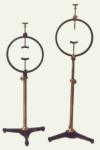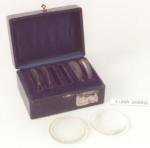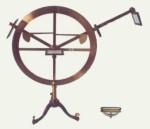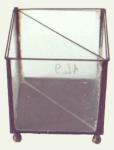 Menu
Menu
|
Function For studies on geometrical optics. |

| ||
|
|||
|
Description The mirror is fixed on a black wooden frame rotating on a horizontal diameter and it is sustained by a fork that is applied to pole raising from a wooden circular basis. | |||
|
Function For studies on geometrical optics. |

| ||
|
|||
|
Description The above bar slides at friction; both can be fixed on the chosen position with set screws. In this way the lens centring is made quickly, as it regards only the height. The apparatus is used for lenses from 15 mm. to 100 mm. | |||
|
Function |

| ||
|
|||
|
Function For studies on geometrical optics. |
| ||
|
|||
|
Description The lenses of 75 mm diameter are mounted on brass feet with variable height applied on iron tripods. | |||
|
Function For studies on geometrical optics. |
| ||
|
|||
|
Description The lenses of 75 mm diameter are mounted on rings rotating on a horizontal diameter. The rings are sustained by forks with variable height placed on a circular basis. The ensemble in made of brass. | |||
|
Function For studies on geometrical optics. |

| ||
|
|||
|
Description A set of lenses of 65 mm diameter placed in a wooden box. All the types of spherical lenses are present.
| |||
|
Function To study the reflection, refraction and the total internal reflection. |

| ||
|
|||
|
Description A vertical circle of 37 cm diameter is divided, on the four quadrants, from 0 to 90 degrees, and it is supported by a tripod. Two independent alidades with an index turn on the axe of the circle. In the circle an index on the alidades gives the angle that they form with the vertical diameter. This is represented by a ruler that individualizes the perpendicular to the reflecting or refracting surface in the incidence point. On the horizontal diameter of the circle we can fix a flat mirror or a hollow half-cylindrical glass that can be filled with some liquid. With the mirror we can verify the reflection law; with the half-cylindrical glass we can verify the laws of refraction, and the total internal reflection. We can also determinate with good approximation the critical angle of the liquid, and the refraction index. | |||
|
Function To study the phenomenon of the refraction |

| ||
|
|||
|
Description The instrument is placed in a container closed with a key. It has a micrometric device, a magnifying telescope (2 or 3 times ), a reducing telescope (to ½ or 1/3) (both with the regulation of the diaphragm) and an objective for microscopes for a direct observation of the crystal and the hemisphere. The latter, with 40 mm diameter, is made of flint glass. Its index of refraction is 1,8904 for the yellow light. We place the crystal on the surface of the hemisphere made of flint glass. The light is reflected by the mirror, crosses through the hemisphere and is reflected by the plane surface of the crystal. Then it goes to the telescope which rotates on a horizontal axis; on this telescope we fix the critical angle of the total internal reflection in correspondence with the intersection of the grating. From the measured angle we can calculate the refraction index. | |||
|
Function To study the phenomenon of the refraction across liquid substancess. |

| ||
|
|||
|
Description The apparatus is made of a cubical brass frame. The bottom is made of brass with four little feet. The lateral surfaces and the diagonal divider are made of glass. The ensemble appears as made of two rectangular prisms. | |||